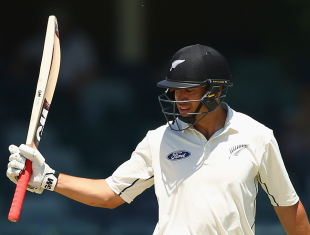Australia v New Zealand, 2015-16

|
|||
|
Related Links
Tour and tournament reports : Australia v New Zealand, 2015-16
Matches:
Australia v New Zealand at W.A.C.A
Series/Tournaments:
New Zealand tour of Australia
Teams:
Australia
| New Zealand
|
|||
At Perth, November 13-17, 2015. Drawn. Toss: Australia.
It is Perthian pre-match tradition to talk things up. This, we are told every year, will be a return to the old WACA pitch: pace, carry, bounce, lightning, nostalgia. But, as so often, looking to the past leads to disappointment. The 2015 edition was more kitchen sponge than trampoline. Nicks, even in the opening overs, didn't carry. Runs were plonked at will. The bowlers couldn't work on swing because the ball kept going out of shape. "Things fall apart; the centre cannot hold," warned W. B. Yeats. And so the icons fell: the WACA dead, the Kookaburra plucked and, some time on the third day, Australia's fourth-highest wicket-taker looked around and asked "What's the point?"
Not since South Africa's visit in December 2005 had a Test here finished as a draw. The malaise was general. The groundsman skulked around with his tail between his legs. Ball manufacturing reps held hushed conversations with journalists. The sightscreen broke down for 17 minutes, and administrators failed to see the humour in the ABC's lighthearted interview with Sunny Munn, its operator. The same administrators had bragged about record crowds for a Brisbane match devoid of atmosphere and priced beyond reason and, while the WACA better suits lower numbers, it suffered the same fate. On that first day in Brisbane, Ryan Harris had a lap of honour around a ground barely a third full; on the fifth in Perth, Mitchell Johnson's Test career petered out in front of a few Tuesday spectators.
But, for fans of batting, there were achievements on display beyond the merely substantial. Again, Smith won the toss; again, New Zealand bowled poorly. This time, Warner went even bigger, scoring more runs on the first day of a Test - 244 - than anyone bar Don Bradman, who made 309 at Leeds in 1930 (and 244 himself at The Oval in 1934). Having faced 200 balls for the first time at Brisbane, Warner followed up with a new personal-best, out early on the second morning from his 286th. Nor was his innings of 253 a whirlwind: it was measured and controlled, balancing risk against reward. Until Taylor trumped him, it was the WACA's second-highest Test score, after Matthew Hayden's then-world-record 380 against Zimbabwe in 2003-04. Khawaja added a century of his own on the first day in a partnership of 302, with the stumps score 416 for two; but he would injure a hamstring in the field the following day, and take no further part in the series.
New Zealand fought back admirably on the second day, bowling tighter lines to a side looking to push on, and defying the conditions to take seven for 143. Henry had some success as the injured Jimmy Neesham's replacement, while Craig profited from Australia's slap-happy approach, but Smith's declaration denied them the satisfaction of bowling his side out.
Deep into the fifth session of the match, New Zealand's batsmen could easily have fallen over. Guptill went fifth ball, and Latham for 36, but this time Williamson found support in Taylor, who had looked so bad in Brisbane that his very career seemed in danger. But the treatment he had received between matches on a growth on his eye had an immediate effect. He relied on thumps through cover, and the pair settled in for a partnership that would reach 265 before Williamson miscued Hazlewood halfway through the third day.
Starc unleashed a terrifically fast new-ball spell, the speed gun alleging 160.4kph (99.66mph), but Taylor fought fire with fire, slashing six boundaries in Starc's six-over burst. With a series of partners in support, he passed Martin Crowe's 188 in 1985-86 to reach the highest New Zealand score against Australia, and started his third day of batting on 235. He finished with 290 - including 43 fours - the highest by an overseas batsman in Australia, passing Englishman Tip Foster's 287, set at Sydney on his debut way back in 1903-04.
With 624, New Zealand had a 65-run lead. It was during this batathon that Johnson found himself, ball in hand, wondering why he was still doing this. If ever a pitch was going to prompt an existential crisis, this was it. Only a mighty collapse would produce a result. Instead, Smith and Voges made centuries in a stand of 224, and Johnson announced his retirement on the final morning.
Australia batted until after lunch, before setting a nominal 321. For a champion player's farewell, such conservative captaincy was tone-deaf. The sparse crowd could only cheer Johnson's last few boundaries with the bat, and his final wickets as he removed New Zealand's openers with two farewell bouncers. But then it was back to Taylor and Williamson, condemning Johnson's last outing to a conclusion as flat as the pitch that hosted it.
Man of the Match: L. R. P. L. Taylor.

